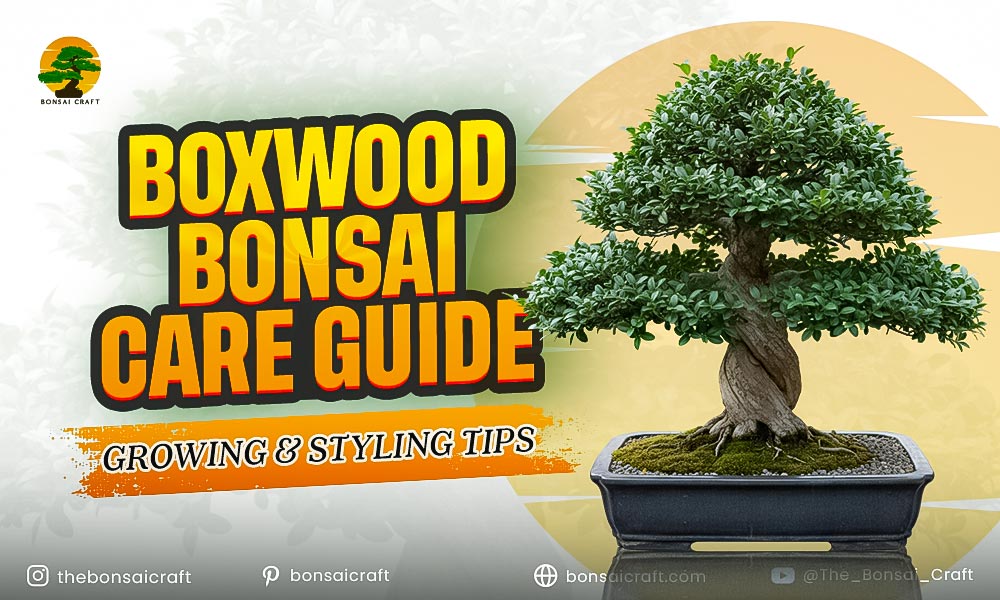
The boxwood bonsai is a timeless favorite in the bonsai community — prized for its dense evergreen foliage, tolerance of heavy shaping, and suitability across many boxwood bonsai styles. Whether you’re working with an English boxwood bonsai, Japanese boxwood bonsai, or experimenting with a dwarf boxwood bonsai, good care transforms a simple shrub into a sculptural bonsai specimen. I’ve worked with buxus bonsai trees for over a decade and will share hands-on, EEAT-driven guidance to help you grow resilient, beautiful bonsai.
Why boxwood is ideal for bonsai
Boxwood bonsai trees are forgiving, compact, and long-lived. Key reasons to choose buxus for bonsai:
- Dense boxwood bonsai leaves allow precise shaping.
- Repeated boxwood bonsai pruning is of no consequence.
- Many styles can be successfully produced: formal upright, broom, forest, and more.
- Numerous cultivars, such as English, Chinese, Japanese, Harland, and Korean boxwood bonsai, will suit a variety of climates and aesthetics.
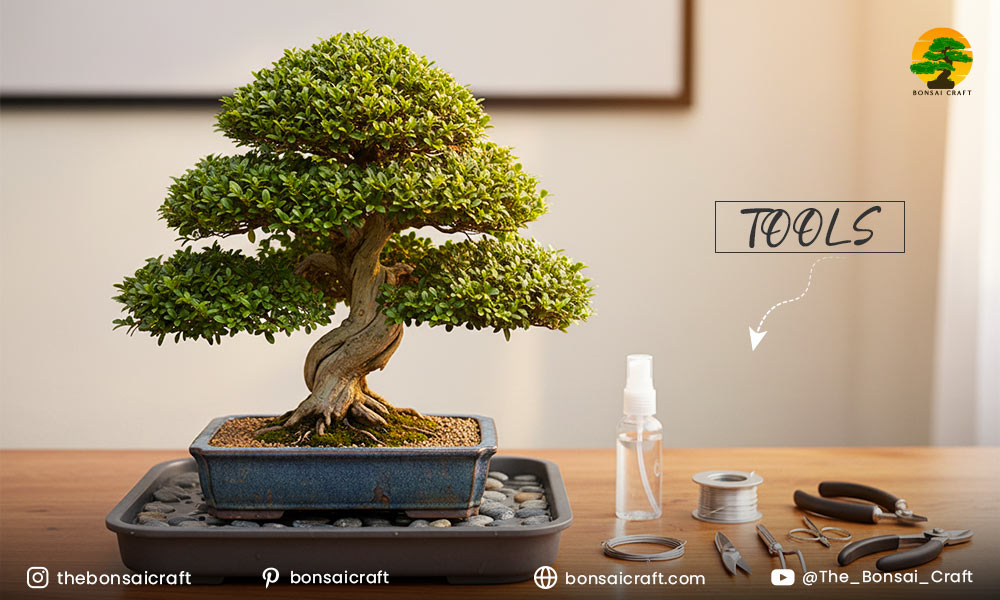
What tools do you need for boxwood bonsai care?
To care for boxwood bonsai, assemble a small bonsai toolkit: sharp concave cutters for clean branch removal, fine shears for silhouette shaping, root rakes and scissors for repotting, aluminum wire for light styling, and humidity trays for indoor trees. Quality tools reduce tissue damage and improve long-term tree health.
Detailed list:
- Concave cutters for branch removal.
- Shears for maintenance trimming and topiary shaping.
- Root rake and scissors for repotting.
- Aluminum wire (1–2 mm) for shaping small branches.
- Humidity trays and a spray bottle for indoor humidity control.
Light and placement: where does a boxwood bonsai thrive?
Boxwood bonsai do best with bright, indirect light and protection from intense midday sun. Outdoors, give morning sun and afternoon shade; indoors, provide strong filtered light or supplemental grow lights, and rotate regularly. Avoid harsh winds or hot, reflective surfaces that can dry leaves rapidly.
Detailed guidance:
- Outdoors: morning sun and afternoon shade; dappled light under a tree is perfect.
- Indoors: a south- or east-facing window works; rotate regularly for even growth.
- Urban balconies or patios: protect from strong winds that desiccate leaves.
Watering and soil for healthy boxwood bonsai
Boxwood bonsai care depends on consistent moisture without waterlogging.
- Soil: Use a well-draining bonsai mix — akadama, pumice, and lava rock in proportions suited to your climate. Add pine bark for slightly more moisture retention in hot, dry areas.
- Watering technique: Water thoroughly until water runs from the drainage holes. Check moisture daily in summer; let the top 10–20 mm (about 1 inch) dry before re-watering.
- Signs of trouble: Yellowing leaves often indicate overwatering; crisp, brown leaf edges suggest underwatering or sun scorch.
How and when to fertilize boxwood bonsai
Feed a bonsai boxwood regularly during active growth.
- Use a balanced slow-release or liquid fertilizer every 2–3 weeks in spring and summer.
- Reduce to monthly in autumn; stop or cut back in winter for temperate, dormancy-prone trees.
- Organic options (fish emulsion or seaweed) help soil biology long-term.
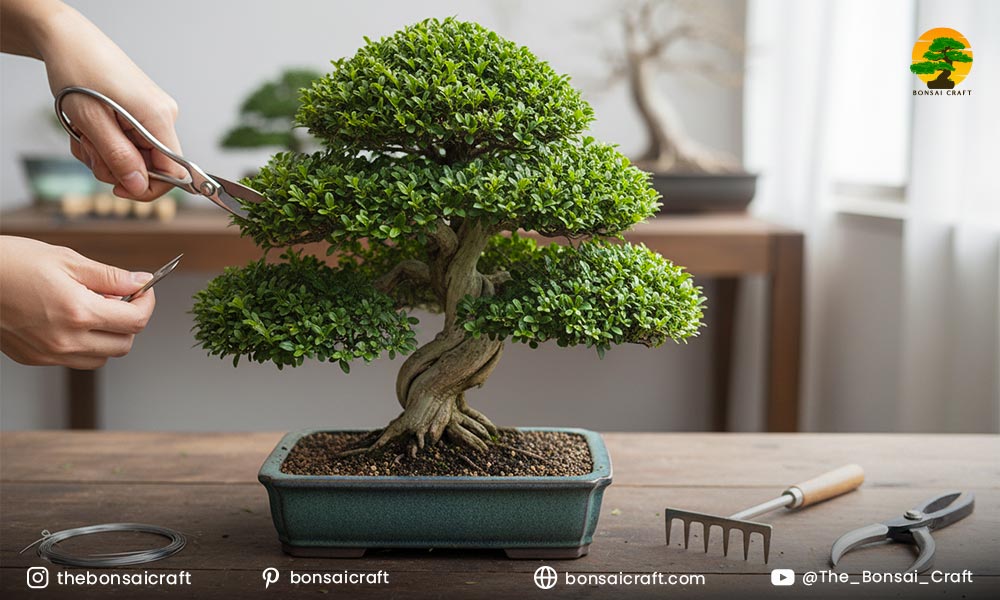
Pruning boxwood bonsai: shaping and maintenance
Effective boxwood bonsai pruning combines light, frequent pinching to build ramification with occasional heavier structural cuts in late winter. Maintain the silhouette by trimming new shoots while avoiding heavy removal of old wood that may not back-bud. Clean, precise cuts speed healing and reduce stress.
Detailed steps:
- Maintenance pruning: Pinch or trim soft growth through spring and summer to maintain silhouette and promote ramification.
- Structural pruning: Late winter or early spring, remove thick branches and define the trunk and primary branches. Avoid cutting into old wood that may not back-bud.
- Topiary shaping: For formal, cloud, or dome shapes, use repetitive clip-and-grow cycles to refine edges.
Wiring and styling boxwood bonsai
Wiring helps position branches, but boxwood bonsai styling favors clip-and-grow methods due to the small branch diameter.
- When to wire: Late spring to early summer when growth is flexible.
- How to wire: Use aluminum wire for small branches; wrap gently at 45° angles. Remove wire before it digs in — typically 6–10 weeks.
- Popular styles: Formal upright (chokkan), informal upright (moyogi), broom (hokidachi), slanting (shakan), and forest (yose-ue).
When to repot and root care
Repot boxwood bonsai trees every 2–3 years when young and 4–5 years for mature specimens, ideally in early spring before budbreak. Trim roughly 25–30% of the root mass, refresh the soil, and position the root flare for an elegant transition from trunk to soil. Recovery needs shading and careful watering.
Detailed guidance:
- Loosen the root ball, remove compacted old soil, prune long roots, and reposition the root flare for aesthetics.
- Soak the soil well before repotting to ease root removal.
- After repotting, keep the tree shaded and reduce fertilizer for 4–6 weeks while roots re-establish.
Best boxwood varieties for bonsai
- English Boxwood (Buxus sempervirens): Classic, dense foliage, great for formal styles.
- Japanese Boxwood (Buxus microphylla): Small leaves, compact growth — extremely popular.
- Chinese/Harland Boxwood (Buxus harlandii): Produces trunks with unique, small leaves.
- Korean Boxwood: A good choice for colder climates.
- Dwarf cultivars: Great for tray and forest plantings.
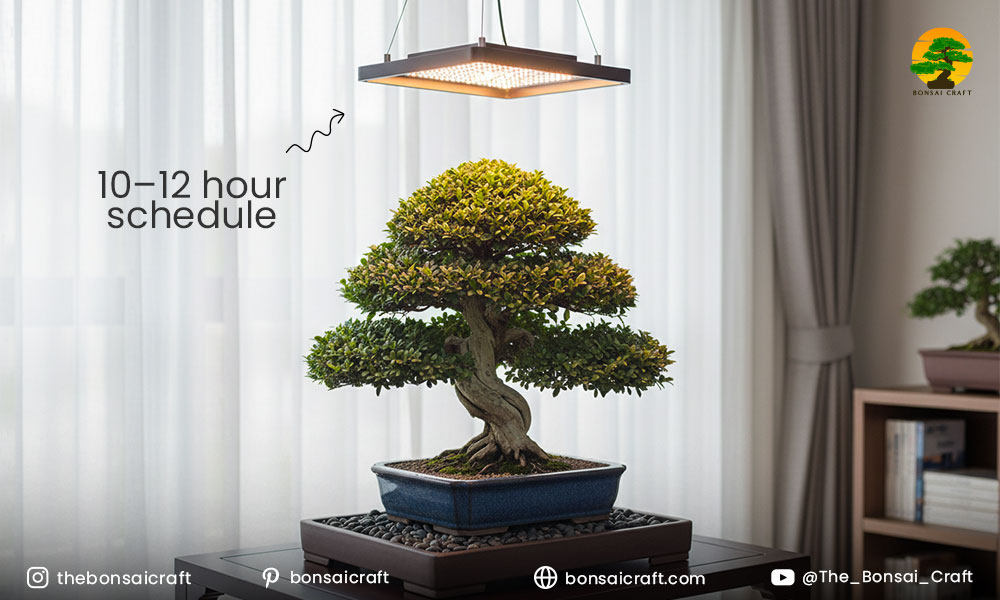
Indoor boxwood bonsai: is it feasible?
An indoor boxwood bonsai can thrive with the correct setup: consistent, strong light, increased humidity, and good air circulation. However, long-term outdoor growth generally produces more vigorous trunks and denser foliage; use indoor cultivation for display or seasonal rotation rather than permanent indoor confinement when possible.
Indoor tips:
- Use full-spectrum grow lights on a 10–12 hour schedule.
- Provide humidity trays and avoid placing them near heating vents.
- Rotate frequently and occasionally place outdoors for seasonal hardening.
Propagation and creating new boxwood bonsai
You can propagate buxus bonsai by cuttings, seeds, or air-layering.
- Cuttings: Semi-hardwood cuttings in summer root reliably in a moist, well-draining medium (perlite/peat). Use rooting hormone for higher success.
- Seeds: Slow and variable — seeds yield genetic diversity but require patience.
- Air-layering: Useful for cloning an attractive trunk section quickly.
Pest and disease management
Common issues in boxwood bonsai care include:
- Boxwood leaf miner — larvae cause brown blistering. Prune affected shoots and treat preventively.
- Boxwood psyllid and mites — use insecticidal soap or neem oil.
- Root rot and fungal issues — improve drainage, avoid overwatering, and apply fungicide if necessary.
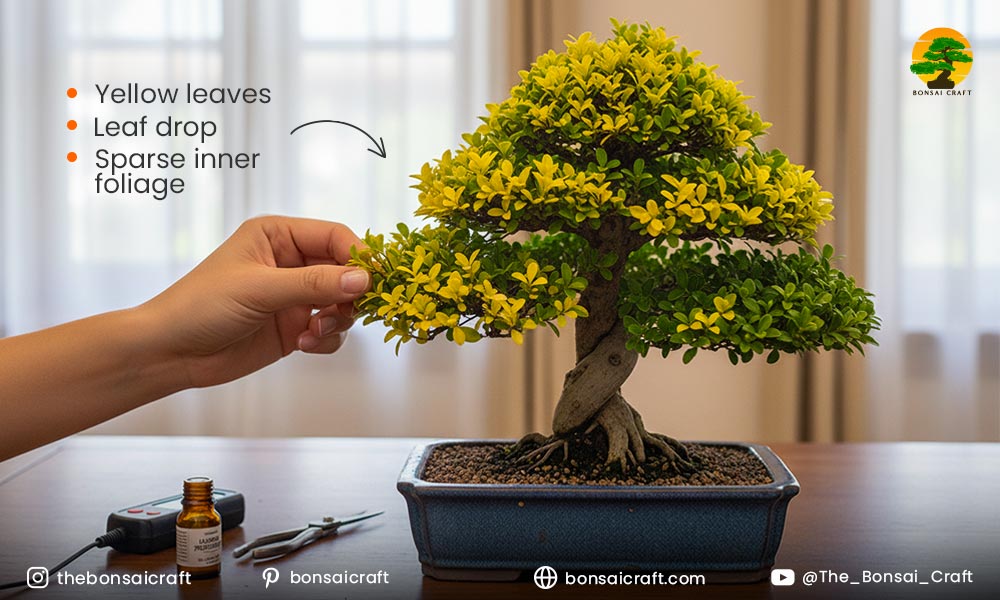
Troubleshooting: yellow leaves, leaf drop, and other problems
- Yellow leaves: Often water-related or nutrient deficiency; test soil drainage and adjust fertilizer.
- Leaf drop: Sudden environmental changes, drafts, or pests. Address the microclimate and inspect closely.
- Sparse inner foliage: Increase light and perform careful thinning to allow internal light penetration.
Advanced styling: bonsai boxwood forests and topiary effects
Boxwood’s dense foliage makes forest plantings and topiary-inspired bonsai dazzling.
- For forests (yose-ue), plant varying heights and stagger drip lines to create a natural perspective.
- For topiary shapes, use repeated clip-and-grow cycles to sculpt domes, cloud layers, or formal geometric forms.
Seasonal calendar for boxwood bonsai care
- Spring: Repot young trees, begin regular fertilizing, and structural pruning.
- Summer: Maintain watering; light shade in peak heat, maintenance pruning.
- Autumn: Reduce feed, prepare for cooler temps, and inspect for pests.
- Winter: Protect roots in cold climates, reduce watering, and minimal pruning unless required for structure.
Sample monthly care schedule for boxwood bonsai
A monthly care rhythm helps maintain boxwood bonsai health: frequent watering and pruning in spring and summer, reduced feeding in autumn, and protection plus sparse watering in winter. Consistent monthly tasks keep your bonsai balanced, healthy, and resilient across seasons.
Monthly rhythm:
- March–May: Repot (if due), structural pruning, weekly feeding.
- June–August: Pinch growth, water daily or as needed, treat pests.
- September–October: Gradually reduce feeding, clean soil surface.
- November–February: Minimal watering, protect from hard freezes.
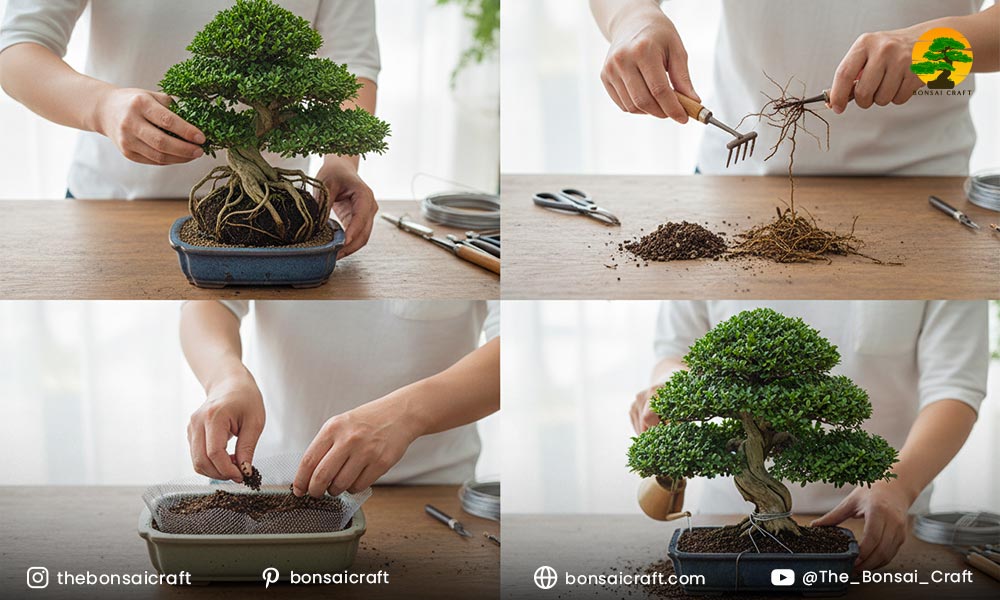
Step-by-step repotting guide
Make sure to conduct root pruning, soil refreshing, and stabilization in the pot. This should take place in early spring, and it is advisable to give the boxwood bonsai root pruning and soil refreshing, and pot stabilization to be done first in early spring and then offer shaded recovering to reduce stress. Method for repotting includes: root work, fresh substrate, secure anchoring, and gentle aftercare to encourage steady regrowth.
Step-by-step repotting:
- Select the pot and prepare fresh bonsai soil.
- Carefully remove the tree and comb the roots out with a root rake.
- Trim fibrous and circling roots and do root pruning to reduce about 25–30%.
- Place a mesh cover over the drainage holes, add soil, position, and backfill.
- Anchor the tree with wire if needed, water well, and keep it shaded for a month.
Advanced pest management and preventive care
Beyond basic sprays, integrate cultural practices: keep soil surface clean, avoid overhead watering in evenings, and improve air circulation. For severe pests (boxwood leaf miner, boxwood psyllid), consult local extension services for recommended systemic treatments and timing of applications.
Soil recipe and proportions
A reliable boxwood bonsai soil mix to start with:
- 40% Akadama (moisture buffering)
- 30% Pumice (aeration)
- 30% Lava rock (drainage)
Adjust ratios by climate: increase pumice in humid areas, add more akadama or pine bark in hot, dry conditions to retain moisture.
Where to learn more (authority links)
For deeper study and regional advice, consult respected resources such as the American Bonsai Society, Bonsai Empire, or your local university extension. Linking to authoritative sources helps validate your care plan and provides region-specific recommendations.
Conclusion
The boxwood bonsai is a rewarding canvas for artistic expression, forgiving, evergreen, and adaptable—master boxwood bonsai care by balancing water, light, pruning, and soil. Start simple, practice clip-and-grow techniques, and gradually explore advanced wiring and forest plantings. From English boxwood bonsai to Japanese boxwood bonsai tree cultivars, consistent attention will yield an elegant living sculpture that can outlive generations.
Expert tip: Keep a care log — noting watering, pruning, and feeding helps you learn your tree’s rhythm and prevents repeated mistakes.
FAQs
Can boxwood be used for bonsai?
Yes. Boxwood bonsai trees are excellent for bonsai because they tolerate heavy pruning, have dense foliage, and adapt well to various styles.
How often should I water a boxwood bonsai?
Water when the top 1 inch of soil feels dry; in summer this may mean daily checks, and in winter every few days depending on indoor conditions.
What is the best boxwood for bonsai?
Japanese boxwood and English boxwood are top choices for small leaves and compact growth.
How do I prune a boxwood bonsai?
Prune regularly by pinching new shoots for maintenance, and perform structural pruning in late winter. Use sharp tools and avoid heavy cuts into old wood.
Can I grow boxwood bonsai indoors?
Yes, but outdoor placement generally produces stronger, healthier trees; indoors, it requires strong light, humidity, and airflow.
